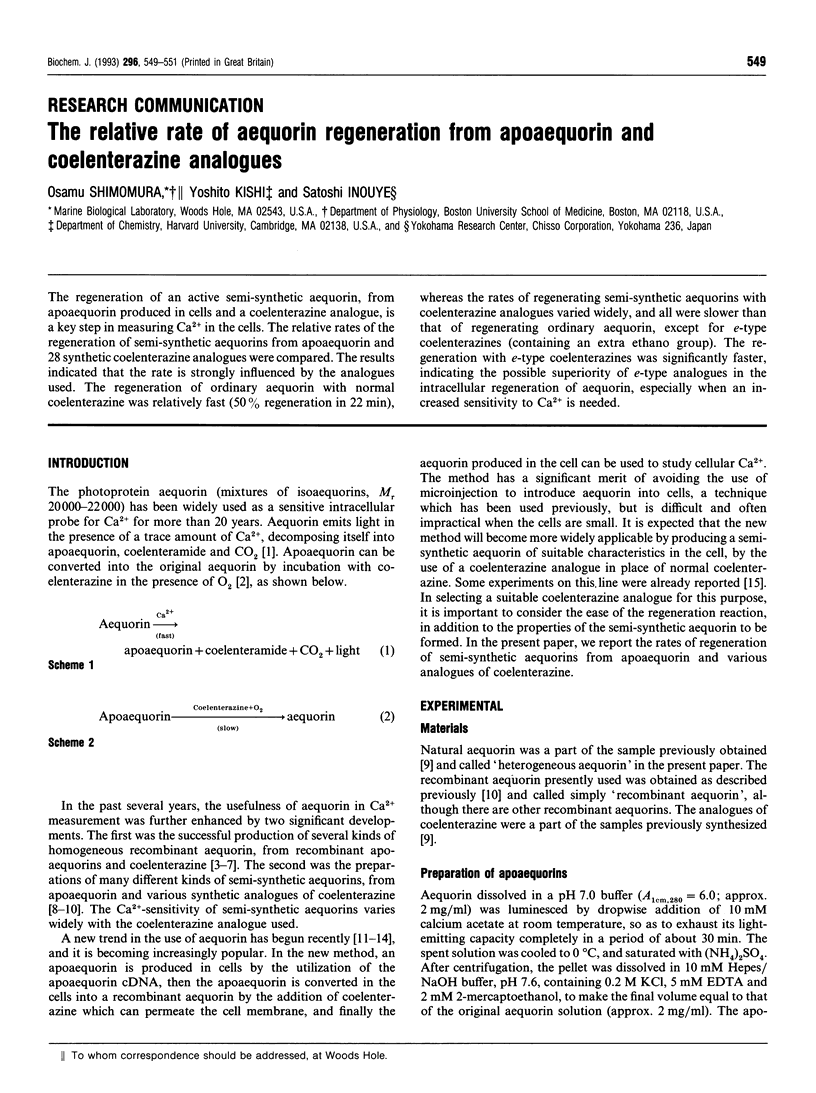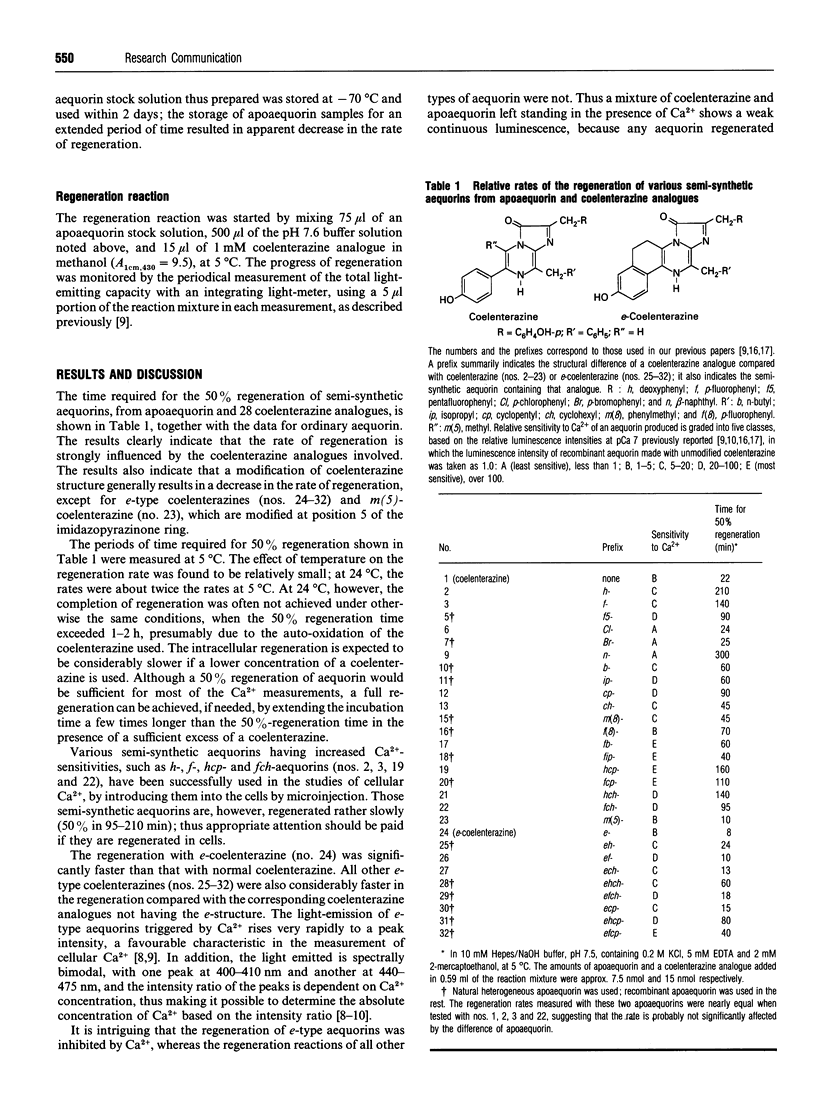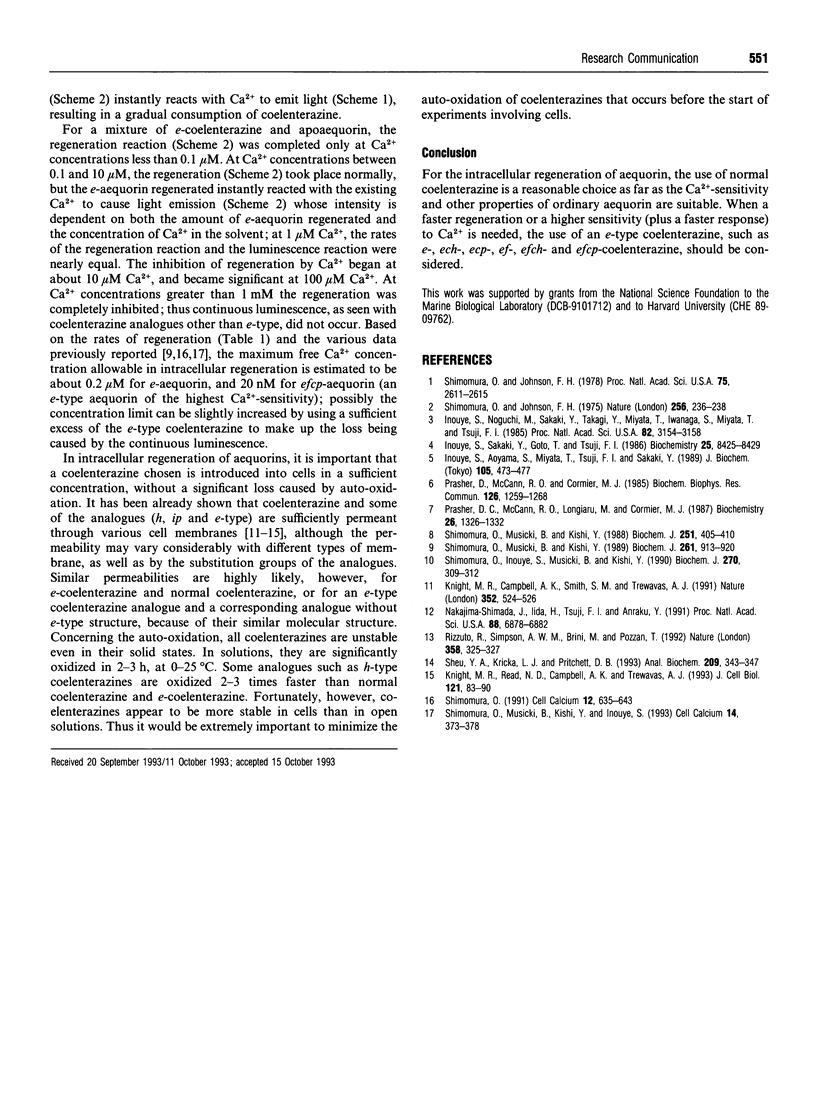Abstract
The regeneration of an active semi-synthetic aequorin, from apoaequorin produced in cells and a coelenterazine analogue, is a key step in measuring Ca2+ in the cells. The relative rates of the regeneration of semi-synthetic aequorins from apoaequorin and 28 synthetic coelenterazine analogues were compared. The results indicated that the rate is strongly influenced by the analogues used. The regeneration of ordinary aequorin with normal coelenterazine was relatively fast (50% regeneration in 22 min), whereas the rates of regenerating semi-synthetic aequorins with coelenterazine analogues varied widely, and all were slower than that of regenerating ordinary aequorin, except for e-type coelenterazines (containing an extra ethano group). The regeneration with e-type coelenterazines was significantly faster, indicating the possible superiority of e-type analogues in the intracellular regeneration of aequorin, especially when an increased sensitivity to Ca2+ is needed.
Full text
PDF


Selected References
These references are in PubMed. This may not be the complete list of references from this article.
- Inouye S., Aoyama S., Miyata T., Tsuji F. I., Sakaki Y. Overexpression and purification of the recombinant Ca2+-binding protein, apoaequorin. J Biochem. 1989 Mar;105(3):473–477. doi: 10.1093/oxfordjournals.jbchem.a122689. [DOI] [PubMed] [Google Scholar]
- Inouye S., Noguchi M., Sakaki Y., Takagi Y., Miyata T., Iwanaga S., Miyata T., Tsuji F. I. Cloning and sequence analysis of cDNA for the luminescent protein aequorin. Proc Natl Acad Sci U S A. 1985 May;82(10):3154–3158. doi: 10.1073/pnas.82.10.3154. [DOI] [PMC free article] [PubMed] [Google Scholar]
- Knight M. R., Campbell A. K., Smith S. M., Trewavas A. J. Transgenic plant aequorin reports the effects of touch and cold-shock and elicitors on cytoplasmic calcium. Nature. 1991 Aug 8;352(6335):524–526. doi: 10.1038/352524a0. [DOI] [PubMed] [Google Scholar]
- Knight M. R., Read N. D., Campbell A. K., Trewavas A. J. Imaging calcium dynamics in living plants using semi-synthetic recombinant aequorins. J Cell Biol. 1993 Apr;121(1):83–90. doi: 10.1083/jcb.121.1.83. [DOI] [PMC free article] [PubMed] [Google Scholar]
- Nakajima-Shimada J., Iida H., Tsuji F. I., Anraku Y. Monitoring of intracellular calcium in Saccharomyces cerevisiae with an apoaequorin cDNA expression system. Proc Natl Acad Sci U S A. 1991 Aug 1;88(15):6878–6882. doi: 10.1073/pnas.88.15.6878. [DOI] [PMC free article] [PubMed] [Google Scholar]
- Prasher D. C., McCann R. O., Longiaru M., Cormier M. J. Sequence comparisons of complementary DNAs encoding aequorin isotypes. Biochemistry. 1987 Mar 10;26(5):1326–1332. doi: 10.1021/bi00379a019. [DOI] [PubMed] [Google Scholar]
- Prasher D., McCann R. O., Cormier M. J. Cloning and expression of the cDNA coding for aequorin, a bioluminescent calcium-binding protein. Biochem Biophys Res Commun. 1985 Feb 15;126(3):1259–1268. doi: 10.1016/0006-291x(85)90321-3. [DOI] [PubMed] [Google Scholar]
- Rizzuto R., Simpson A. W., Brini M., Pozzan T. Rapid changes of mitochondrial Ca2+ revealed by specifically targeted recombinant aequorin. Nature. 1992 Jul 23;358(6384):325–327. doi: 10.1038/358325a0. [DOI] [PubMed] [Google Scholar]
- Sheu Y. A., Kricka L. J., Pritchett D. B. Measurement of intracellular calcium using bioluminescent aequorin expressed in human cells. Anal Biochem. 1993 Mar;209(2):343–347. doi: 10.1006/abio.1993.1132. [DOI] [PubMed] [Google Scholar]
- Shimomura O., Inouye S., Musicki B., Kishi Y. Recombinant aequorin and recombinant semi-synthetic aequorins. Cellular Ca2+ ion indicators. Biochem J. 1990 Sep 1;270(2):309–312. doi: 10.1042/bj2700309. [DOI] [PMC free article] [PubMed] [Google Scholar]
- Shimomura O., Johnson F. H. Peroxidized coelenterazine, the active group in the photoprotein aequorin. Proc Natl Acad Sci U S A. 1978 Jun;75(6):2611–2615. doi: 10.1073/pnas.75.6.2611. [DOI] [PMC free article] [PubMed] [Google Scholar]
- Shimomura O., Johnson F. H. Regeneration of the photoprotein aequorin. Nature. 1975 Jul 17;256(5514):236–238. doi: 10.1038/256236a0. [DOI] [PubMed] [Google Scholar]
- Shimomura O., Musicki B., Kishi Y., Inouye S. Light-emitting properties of recombinant semi-synthetic aequorins and recombinant fluorescein-conjugated aequorin for measuring cellular calcium. Cell Calcium. 1993 May;14(5):373–378. doi: 10.1016/0143-4160(93)90041-4. [DOI] [PubMed] [Google Scholar]
- Shimomura O., Musicki B., Kishi Y. Semi-synthetic aequorin. An improved tool for the measurement of calcium ion concentration. Biochem J. 1988 Apr 15;251(2):405–410. doi: 10.1042/bj2510405. [DOI] [PMC free article] [PubMed] [Google Scholar]
- Shimomura O., Musicki B., Kishi Y. Semi-synthetic aequorins with improved sensitivity to Ca2+ ions. Biochem J. 1989 Aug 1;261(3):913–920. doi: 10.1042/bj2610913. [DOI] [PMC free article] [PubMed] [Google Scholar]
- Shimomura O. Preparation and handling of aequorin solutions for the measurement of cellular Ca2+. Cell Calcium. 1991 Oct;12(9):635–643. doi: 10.1016/0143-4160(91)90060-r. [DOI] [PubMed] [Google Scholar]


